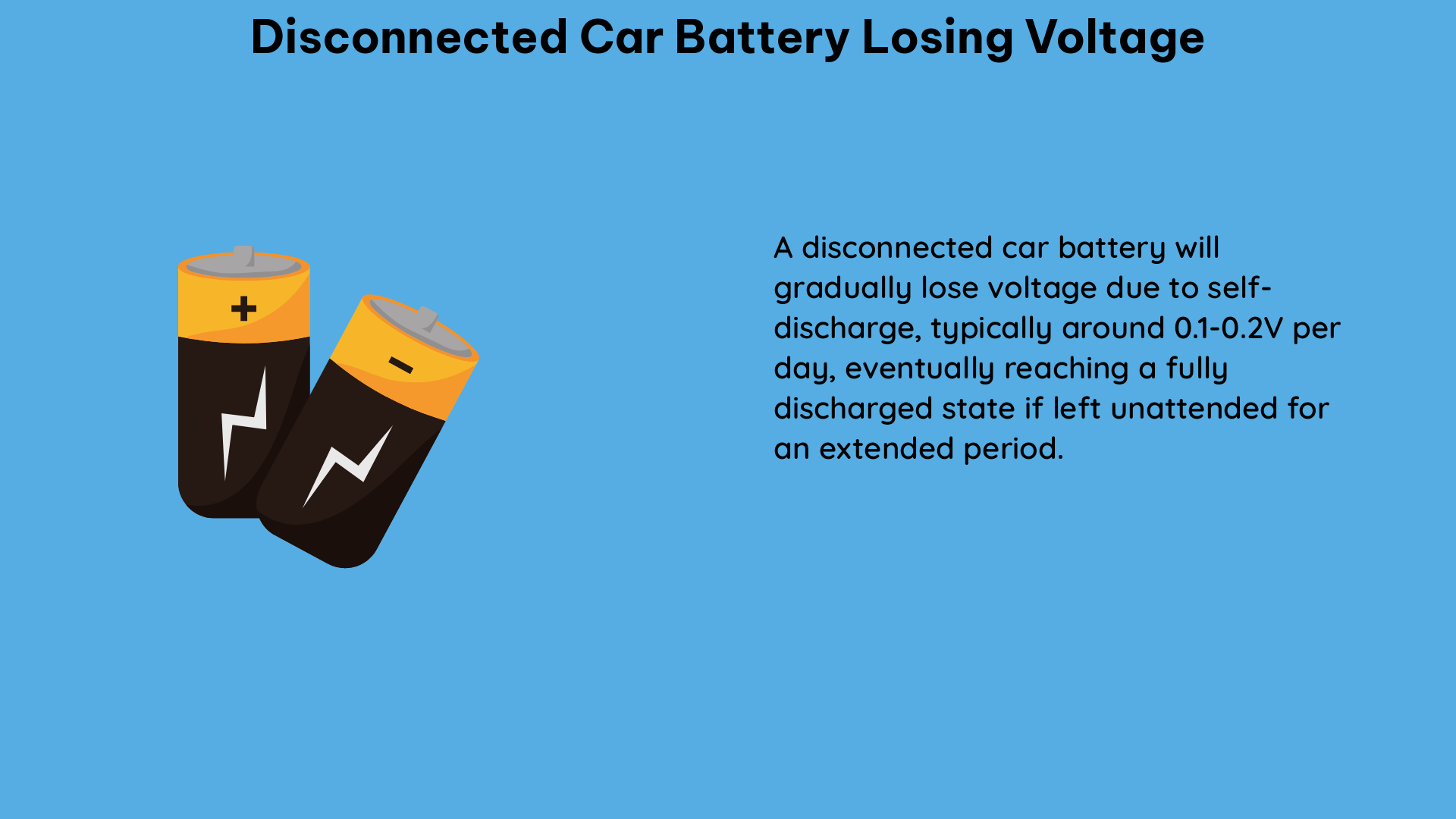When a car battery is disconnected, it will gradually lose its charge over time due to internal resistance and self-discharge. This phenomenon is a common concern for car owners, and understanding the technical details behind it can help you better manage your battery’s health and performance.
Understanding Lead-Acid Battery Voltage Dynamics
Lead-acid batteries, the most common type used in cars, exhibit specific voltage characteristics when disconnected from the vehicle’s electrical system. Here’s a closer look at the technical details:
Voltage Range:
– Fully charged lead-acid battery: 12.7V
– Minimum healthy voltage: 12.0V
– Voltage range for a disconnected lead-acid battery: 12.0V to 12.7V
Self-Discharge Rate:
– The self-discharge rate of a lead-acid battery varies depending on several factors:
– Battery age: Older batteries tend to have higher self-discharge rates.
– Battery type: Different lead-acid battery technologies (e.g., flooded, AGM, gel) have varying self-discharge characteristics.
– Temperature: Higher temperatures accelerate the self-discharge process.
Voltage Decrease Over Time:
– A fully charged lead-acid battery may lose approximately 0.25V to 0.45V within the first few hours of being disconnected.
– After the initial voltage drop, the battery may continue to lose voltage at a rate of 0.1V to 0.2V per day, depending on the factors mentioned above.
Factors Affecting Voltage Loss in Disconnected Batteries

Several factors can influence the rate at which a disconnected car battery loses its voltage. Understanding these factors can help you better manage your battery’s performance.
Battery Age and Condition
- Older batteries or batteries that have experienced deep discharges tend to have higher self-discharge rates, leading to faster voltage loss when disconnected.
- Batteries nearing the end of their lifespan may also exhibit accelerated voltage drop due to internal resistance and degradation.
Temperature
- Ambient temperature plays a significant role in the self-discharge rate of lead-acid batteries.
- Higher temperatures (above 25°C/77°F) can increase the self-discharge rate, leading to faster voltage loss in disconnected batteries.
- Conversely, lower temperatures (below 10°C/50°F) can slow down the self-discharge process, helping the battery maintain its voltage for a more extended period.
Battery Chemistry and Design
- Different lead-acid battery technologies, such as flooded, AGM (Absorbent Glass Mat), and gel, have varying self-discharge characteristics.
- AGM and gel batteries generally have lower self-discharge rates compared to flooded lead-acid batteries.
Parasitic Loads
- Even when a car battery is disconnected, there may be small parasitic loads, such as clock memories or security systems, that continue to draw a small amount of current from the battery.
- These parasitic loads can contribute to the battery’s self-discharge and accelerate the voltage drop.
Measuring Voltage of a Disconnected Car Battery
Accurately measuring the voltage of a disconnected car battery is crucial for assessing its health and charge state. Here’s a step-by-step guide on how to do it:
-
Ensure the Battery is at Rest: Before measuring the voltage, make sure the battery has not been charged or discharged for at least a few hours. This allows the battery to reach a stable voltage level.
-
Use a Digital Multimeter: Employ a high-quality digital multimeter to measure the battery’s voltage. Analog voltmeters may not provide accurate readings.
-
Connect the Multimeter Probes: Connect the multimeter’s red probe to the battery’s positive terminal and the black probe to the negative terminal.
-
Record the Voltage Reading: Note down the voltage reading displayed on the multimeter. This will be the battery’s current voltage level.
-
Interpret the Voltage Reading:
- Healthy battery voltage: 12.0V or higher
- Voltage below 12.0V: Indicates a weak or damaged battery that may need recharging or replacement
Maintaining a Disconnected Car Battery
To minimize voltage loss and maintain the health of a disconnected car battery, follow these best practices:
-
Store the Battery in a Cool, Dry Place: Keep the battery in a cool, dry environment, as high temperatures can accelerate the self-discharge process.
-
Keep the Battery Fully Charged: Ensure the battery is fully charged before disconnecting it. Use a battery maintainer or trickle charger to keep the battery at a full charge state while it’s disconnected.
-
Minimize Parasitic Loads: Identify and disconnect any potential parasitic loads, such as security systems or clocks, that may be drawing power from the battery even when it’s disconnected.
-
Check the Battery Periodically: Regularly check the battery’s voltage using a digital multimeter to monitor its charge state. If the voltage drops below 12.0V, consider recharging or replacing the battery.
-
Avoid Deep Discharges: Prevent the battery from being deeply discharged, as this can accelerate its degradation and increase the self-discharge rate.
By understanding the technical details and following these best practices, you can effectively manage the voltage loss in your disconnected car battery and ensure its optimal performance.
References:
– Reddit Discussion on Disconnected Car Battery Voltage Decreasing Fast
– Mechanics StackExchange: Car Battery Dying Overnight Disconnected
– Taurus Club Thread: Normal Resistance Between Positive and Negative Leads When Battery Disconnected
– DSM Tuners Thread: Battery Voltage Drops When Terminals Connected
– JustAnswer: Car Battery Completely Disconnected

The lambdageeks.com Core SME Team is a group of experienced subject matter experts from diverse scientific and technical fields including Physics, Chemistry, Technology,Electronics & Electrical Engineering, Automotive, Mechanical Engineering. Our team collaborates to create high-quality, well-researched articles on a wide range of science and technology topics for the lambdageeks.com website.
All Our Senior SME are having more than 7 Years of experience in the respective fields . They are either Working Industry Professionals or assocaited With different Universities. Refer Our Authors Page to get to know About our Core SMEs.